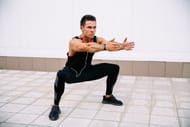It's important to incorporate weight training exercises into your routine before you head out for your next hike. Hiking and backpacking are great ways to experience nature, but they can also provide an intense aerobic workout which require ample strength.
As you gain both weight and distance, the amount of work needed to cover ground becomes more taxing on your body, especially if you are hiking farther than anticipated or your pack is heavier. Weight training exercises can help prevent injuries and improve performance when you're on the trail.
Best Weight Training Exercises to Prepare for Hiking
Here are seven best weight training exercises to help you prepare for backpacking and hiking:
1) Goblet Squats

Goblet squats generally work the quads and glutes, but they also work the hamstrings and adductors, making them a great weight training exercise for hiking. Increase the weight you use as you get stronger, or practice squatting on a BOSU ball to provide a challenge to your core and balance.
Here's how you do it:
- Stand with your feet slightly wider than shoulder width apart and your toes pointing around 5-10 degrees forward or outward. Your hips should also be rotated externally.
- Raise a kettlebell or dumbbell to your chest.
- Take a deep breath, and push your hips backwards, as if you were reaching for your butt back to sit on a chair.
- Make sure your core is engaged, chest is lifted, and back is straight.
2) Weighted Step-up
Weighted step-ups are a great weight training exercise for hiking that works many muscles in your lower body simultaneously. It's effective for strengthening your legs, making it a great cardiovascular workout as well.

To do weighted step-ups:
- Stand in front of a knee-high or slightly shorter bench, plyometric box or step. Keep your arms at your sides, and relax.
- Step up onto the box with your right foot, engaging your core and glutes. To propel your body upward, use your arms.
- Bring your left leg up onto the box as well, allowing you to stand on top of it.
- Return to your original position by stepping backwards with your right foot first, followed by your left.
3) Single-Leg Romanian Deadlift
The single-leg Romanian deadlift can strengthen the glutes, hamstrings and stabilising muscles, which are important for injury prevention on the trail. This weight training exercise provides all the good posterior chain activation advantages of regular deadlifts while also improving single-leg stability, making them more effective for hiking.
Here's how you do it:
- Raise one leg off the floor, with your feet shoulder-width apart and knees slightly bent.
- Flex the knee on your standing/support leg about 15-20% to stimulate the glutes.
- Keep your back naturally arched; bend (hinge) at your hips, and lower your body till it's virtually parallel to the floor, without changing the bend in your knee.
- Squeeze your glutes; press your hips forward, and bring your torso back to the starting position after a little pause at the bottom.
- Repeat till you've completed the required number of reps.
4) Bulgarian Split Squat

Split squats are an excellent weight training exercise for building the lower body, core, and spinal extensor muscles. This form elevates your back foot, promotes hamstring, quad, and hip activation, which is similar to hiking.
To do Bulgarian split squat:
- Stand three feet in front of a bench, facing away with your back foot propped up on the bench behind you.
- Maintain a split squat/lunge by bending your front knee and keeping your shoulders back and core engaged.
- To go back to standing, press through your heel till the thigh of your front leg is parallel to the ground.
- Per set, do 8-10 reps per leg.
5) Stability Ball Hamstring Curls
All your hiking stages rely heavily on your hamstrings. This weight training exercise also works your abdomen, glute muscles and hip flexors, all of which work together to help you keep your balance on the course.
To do this exercise:
- On a stability ball, lie on your back with your legs straight and heels raised. Place your palms down on the mat with your arms at your sides.
- Lift your hips up with your core and glutes engaged so that your body is in a straight line from your heels to your head. Your shoulder blades should be pressed against the mat.
- Press your heels into the ball, and engage your hamstrings.
- Bring the ball to your buttocks by bending your knees.
- Return to your original starting position.
6) Jump Squats

All the key leg muscles involved in hiking, such as the glutes, quadriceps and hamstrings, are strengthened with jumping squats. This weight training exercise will also provide you a cardio boost, so you'll no longer be out of breath after steep uphill treks.
To do jump squats:
- Start with your feet, keeping enough distance for jump squats.
- Bend your knees, and sit your hips all the way back, as if reaching your butt back to sit on a chair, to get into a squat.
- Jump as high as you can vertically into the air, reaching for the ceiling.
- As soon as you touch down, bend your knees to cushion the landing.
- For 60 seconds, jump as high and as quickly as you can.
7) Single-Leg Calf Raises
The calves are mostly used for uphill hiking and can rapidly become fatigued if not properly trained with weight training exercises. Fortunately, they're a simple target for this exercise.
To do this move:
- With your heels dangling off the back of a step or box, stand on one leg. Hook your second foot behind the supporting leg's ankle.
- In the opposing arm, hold a dumbbell.
- Drop your heel so that you're sinking into it; elevate up onto your toes so that you're standing on your tiptoes.
As hikers, the three primary muscles we are concerned with are the quadriceps, hamstrings and glutes.
It doesn't matter if you're walking around your hometown or trekking thousands of miles though the wilderness—the stronger these muscles are, the more you can walk with ease and extend your hiking trips.
